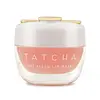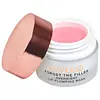What's inside
What's inside
 Key Ingredients
Key Ingredients

 Benefits
Benefits

 Concerns
Concerns

 Ingredients Side-by-side
Ingredients Side-by-side

Triisostearin
Skin ConditioningPolyglyceryl-2 Triisostearate
EmulsifyingSqualane
EmollientDextrin Palmitate
EmulsifyingVp/Hexadecene Copolymer
Silica
AbrasiveDextrin Palmitate/Ethylhexanoate
EmulsifyingCamellia Japonica Seed Oil
EmollientPrunus Persica Kernel Extract
MoisturisingPrunus Persica Juice
MoisturisingPrunus Persica Leaf Extract
EmollientCitrus Unshiu Peel Extract
MaskingSaccharomyces/Rice Ferment Filtrate
Skin ConditioningCamellia Sinensis Leaf Extract
AntimicrobialCladosiphon Okamuranus Extract
Skin ConditioningAllantoin
Skin ConditioningStearyl Glycyrrhetinate
Skin ConditioningTocopherol
AntioxidantPyridoxine Hcl
Skin ConditioningWater
Skin ConditioningPropanediol
SolventButylene Glycol
HumectantEthylhexylglycerin
Skin ConditioningParfum
MaskingPhenoxyethanol
PreservativeLimonene
PerfumingLinalool
PerfumingCI 77491
Cosmetic ColorantTriisostearin, Polyglyceryl-2 Triisostearate, Squalane, Dextrin Palmitate, Vp/Hexadecene Copolymer, Silica, Dextrin Palmitate/Ethylhexanoate, Camellia Japonica Seed Oil, Prunus Persica Kernel Extract, Prunus Persica Juice, Prunus Persica Leaf Extract, Citrus Unshiu Peel Extract, Saccharomyces/Rice Ferment Filtrate, Camellia Sinensis Leaf Extract, Cladosiphon Okamuranus Extract, Allantoin, Stearyl Glycyrrhetinate, Tocopherol, Pyridoxine Hcl, Water, Propanediol, Butylene Glycol, Ethylhexylglycerin, Parfum, Phenoxyethanol, Limonene, Linalool, CI 77491
Hydrogenated Polyisobutene
EmollientHydrogenated Poly(C6-14 Olefin)
EmollientCaprylic/Capric Triglyceride
MaskingButyrospermum Parkii Butter
Skin ConditioningEthylene/Propylene/Styrene Copolymer
Synthetic Candelilla Wax
EmollientSynthetic Wax
Abrasive1,2-Hexanediol
Skin ConditioningTribehenin
EmollientEthylhexyl Palmitate
EmollientGlyceryl Caprylate
EmollientMenthoxypropanediol
MaskingButylene/Ethylene/Styrene Copolymer
Caprylyl Glycol
EmollientAroma
Pentaerythrityl Tetra-Di-T-Butyl Hydroxyhydrocinnamate
AntioxidantPrunus Amygdalus Dulcis Oil
Skin ConditioningRosa Canina Fruit Oil
EmollientSorbitan Isostearate
EmulsifyingWater
Skin ConditioningButylene Glycol
HumectantZingiber Officinale Root Extract
MaskingBHT
AntioxidantPalmitoyl Tripeptide-1
Skin ConditioningPolyglyceryl-2 Triisostearate
EmulsifyingAluminum Hydroxide
EmollientCeramide NP
Skin ConditioningSodium Hyaluronate
HumectantEuterpe Oleracea Fruit Extract
Fragaria Chiloensis Fruit Extract
Skin ConditioningHydroxypropyltrimonium Hyaluronate
Lycium Chinense Fruit Extract
AntioxidantMorus Nigra Fruit Extract
Skin ConditioningRibes Nigrum Fruit Extract
AstringentRubus Fruticosus Fruit Extract
AstringentRubus Idaeus Fruit Extract
AstringentVaccinium Angustifolium Fruit Extract
Skin ProtectingVaccinium Macrocarpon Fruit Extract
AstringentVaccinium Myrtillus Fruit Extract
Skin ConditioningHydrolyzed Hyaluronic Acid
HumectantSodium Acetylated Hyaluronate
HumectantHyaluronic Acid
HumectantHydrolyzed Sodium Hyaluronate
Skin ConditioningSodium Hyaluronate Crosspolymer
HumectantPotassium Hyaluronate
Skin ConditioningLactic Acid
BufferingCitric Acid
BufferingCI 15850
Cosmetic ColorantCI 15985
Cosmetic ColorantHydrogenated Polyisobutene, Hydrogenated Poly(C6-14 Olefin), Caprylic/Capric Triglyceride, Butyrospermum Parkii Butter, Ethylene/Propylene/Styrene Copolymer, Synthetic Candelilla Wax, Synthetic Wax, 1,2-Hexanediol, Tribehenin, Ethylhexyl Palmitate, Glyceryl Caprylate, Menthoxypropanediol, Butylene/Ethylene/Styrene Copolymer, Caprylyl Glycol, Aroma, Pentaerythrityl Tetra-Di-T-Butyl Hydroxyhydrocinnamate, Prunus Amygdalus Dulcis Oil, Rosa Canina Fruit Oil, Sorbitan Isostearate, Water, Butylene Glycol, Zingiber Officinale Root Extract, BHT, Palmitoyl Tripeptide-1, Polyglyceryl-2 Triisostearate, Aluminum Hydroxide, Ceramide NP, Sodium Hyaluronate, Euterpe Oleracea Fruit Extract, Fragaria Chiloensis Fruit Extract, Hydroxypropyltrimonium Hyaluronate, Lycium Chinense Fruit Extract, Morus Nigra Fruit Extract, Ribes Nigrum Fruit Extract, Rubus Fruticosus Fruit Extract, Rubus Idaeus Fruit Extract, Vaccinium Angustifolium Fruit Extract, Vaccinium Macrocarpon Fruit Extract, Vaccinium Myrtillus Fruit Extract, Hydrolyzed Hyaluronic Acid, Sodium Acetylated Hyaluronate, Hyaluronic Acid, Hydrolyzed Sodium Hyaluronate, Sodium Hyaluronate Crosspolymer, Potassium Hyaluronate, Lactic Acid, Citric Acid, CI 15850, CI 15985
 Reviews
Reviews

Ingredients Explained
These ingredients are found in both products.
Ingredients higher up in an ingredient list are typically present in a larger amount.
Butylene Glycol (or BG) is used within cosmetic products for a few different reasons:
Overall, Butylene Glycol is a safe and well-rounded ingredient that works well with other ingredients.
Though this ingredient works well with most skin types, some people with sensitive skin may experience a reaction such as allergic rashes, closed comedones, or itchiness.
Learn more about Butylene GlycolThis ingredient is a form of glycerin with emulsifying and emollient properties.
As an emulsifier, this ingredient helps keep products together while adding a thick texture. The manufacturer states this ingredient has emollient properties. Emollients help keep the skin hydrated by trapping moisture in.
Polyglyceryl-2 Triisostearate is created by reacting diglycerin and isostearic acid. Due to the isostearic acid base, it may not be safe for Malassezia or fungal acne.
Learn more about Polyglyceryl-2 TriisostearateWater. It's the most common cosmetic ingredient of all. You'll usually see it at the top of ingredient lists, meaning that it makes up the largest part of the product.
So why is it so popular? Water most often acts as a solvent - this means that it helps dissolve other ingredients into the formulation.
You'll also recognize water as that liquid we all need to stay alive. If you see this, drink a glass of water. Stay hydrated!
Learn more about Water